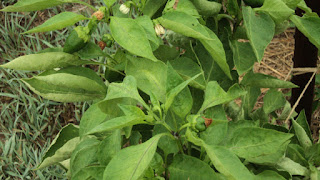cucurbit family fruit
COLORFUL CARROTS (F/P) This may be the last week of these. Thank you carrots of all colors for nourishing us during a brutal summer!
YELLOW OR RED ONIONS (F/P) The yellow onions are our best keepers and they’ve got a bite to prove it.
WATERMELON, CANTALOUPE OR PUMPKIN (F/P) We realize this is an odd-ball of a choice, but it is what we have. Choose which big ball of fruit you want.
HOT PEPPERS (F) We continue to have a lot of hot peppers, one of the few fruiting plants that is not affected by high temperatures.
RATTLESNAKE BEANS (F) Precious, precious beans! Finally after months of watching six rows of beans sit and do nothing in the heat, our pole beans are ready to be picked. ‘Snake’ beans can get big but they stay tender and have a nice nutty flavor. Partial shares will get them next week and hopefully the full shares will too.
OKRA, BEETS OR EGGPLANT (P) The last of the beets until fall. Okra and eggplant should be going on for awhile more.
GREENS CHOICE (F) There is some kale and collard plants that need to be picked. They won’t be big bunches but it is nice to have something green for a change.
HERB CHOICE (F/P) We are sending in more dried herbs along with sage and thyme.
NEXT WEEK: More tomatoes, peppers, okra, eggplant, and beans. Arugula and radishes, we hope. Garlic returns.
FARM REPORT:
The big news on the farm is the glorious high tunnel taking shape over in its corner of the farm. See Tom’s post for more on the work day on Sunday, but I must say we are stupendously fortunate to have such capable, friendly folks in our corner. We slopped around in the mud together and cogitated over the plans together and in the end we managed to get a lot done and have a good time doing it. Today we began seeding the plants that will call the high tunnel home in about a month’s time.
Lettuces, bok choy, bunching onions, beets, and bulb fennel are seeded so far. Also on the list to enter the tunnel: radishes, carrots, young turnips, spinach, arugula, swiss chard, rapini and endive. Since we have never done this before we are very hesitant to predict how the season will turn out, but we hope to offer an extension of the CSA season by three weeks to a maximum of 50 current CSA members. The twenty-fourth and final week of the regular CSA season will be the week ending October 20th. Once we get to October, we will ask you to let us know if you would like to extend your share.
beneficial insect: predatory lacewing
In the meantime, we are looking forward to the beginning of a new harvest season. The small bunches of kale and collards are ushering us into what looks to be a bountiful fall. The 0.75 inch rain on Sunday gave the thousands of baby seedlings a nice drink, but six inches down the soil is still dry. The irrigation pump stays on to supplement what nature provides. We are keeping an eye on Hurricane Isaac but it is unclear if any rain will get here. So far we are a foot of rain below average for the year. We hope that everyone stays safe down in the Gulf Coast and that they send some of their extra moisture on up to us.





















